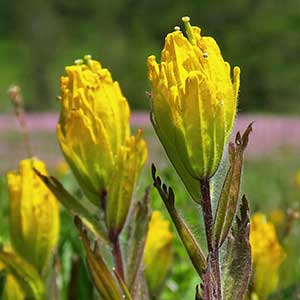Castilleja levisecta
Castilleja victoriae
golden Indian paintbrush, golden paintbrush
Victoria owl-clover, Victoria paintbrush, Victoria's owl's-clover, Victoria's owl-clover, Victoria's paintbrush
few to many, erect, ± decumbent or creeping at base, unbranched, sometimes branched, hairs spreading, medium length and long, soft, mixed with short stipitate-glandular ones.
solitary, erect, unbranched, sometimes branched, hairs spreading, long, soft, mixed with short stipitate-glandular ones.
green to purple or brown-tinged, linear-lanceolate proximally, oblong-ovate or -obovate distally, 0.8–5.2 cm, not fleshy, margins plane, distalmost sometimes ± wavy, involute, 3–7(–11)-lobed, apex obtuse;
lobes erect to ascending, linear to linear-spatulate, very short, toothlike, usually arising from distal 1/3 of blade, apex rounded.
usually brownish throughout, sometimes greenish proximally, brownish distally, margins deep brown, lanceolate to narrowly ovate, 0.5–2.7 cm, not fleshy, margins plane, involute, 0–3(–5)-lobed, apex acute;
lobes spreading-ascending, linear to lanceolate, apex acute, obtuse, or rounded.
2.5–25 × 1–4 cm;
bracts bright yellow throughout, or proximally greenish, distally bright yellow, sometimes deep yellow-orange, especially with age, oblong, elliptic, or obtuse to ovate, (0–)5–9(–13)-lobed, sometimes wavy-margined;
lobes erect to ascending, oblong, short to medium length, arising above mid length, central lobe apex rounded, lateral ones rounded to acute.
1–5 × 1.5–3 cm;
bracts dull reddish brown throughout, or proximally dull greenish, distally dull reddish brown, narrowly ovate, 3–7-lobed;
lobes ascending, lanceolate, medium length, arising near or above mid length, apex broadly acute or obtuse.
straight or slightly curved, 17–28 mm;
tube 12–15 mm;
beak exserted, adaxially green or greenish yellow, 6–8 mm;
abaxial lip yellow or greenish, reduced, not inflated, 2–3 mm, 25–33(–50)% as long as beak;
teeth ascending to erect, yellow, 0.5–1.5 mm.
straight, 10–18 mm;
tube 9–13 mm;
abaxial lip and beak exserted;
beak adaxially white, sometimes faintly diffuse purple, 3 mm, inconspicuously puberulent, hairs short stipitate-glandular;
abaxial lip yellowish, cream, or soft pale yellow, lacking spots, moderately conspicuous, pouches 3, conspicuous, 1–3 mm deep, central one furrowed, conspicuous, 2–2.5 mm, 60–75% as long as beak;
teeth erect, white or cream, 0.5–0.8 mm.
distally yellow, 13–22 mm;
abaxial and adaxial clefts 4–9.5 mm, 30–40% of calyx length, deeper than laterals, lateral 2.5–4.5 mm, ca. 25% of calyx length;
lobes linear to narrowly oblong or narrowly lanceolate, apex obtuse, sometimes rounded to acute.
colored as bracts, 8–12 mm;
abaxial and adaxial clefts 5–6 mm, 50% of calyx length, deeper than laterals, lateral 3–4 mm, 30–40% of calyx length;
lobes linear-lanceolate, apex acute.
included in beak.
= 24.
= 24.
Castilleja levisecta
Castilleja victoriae
Castilleja levisecta is listed as threatened in the United States and endangered in Canada, where it is extremely rare. Most of its grassland habitat has been altered by development in the Puget Trough, and there are historical stations in the metro areas of what are now Victoria, Portland, and Seattle. For several decades, C. levisecta was considered extirpated from Oregon. However, recent reintroduction programs in Oregon and Washington have been very successful at reestablishing this species at several sites in the Willamette Valley. The bright yellow inflorescences often gradually age to a golden yellow color, unique in the genus.
Castilleja levisecta is in the Center for Plant Conservation’s National Collection of Endangered Plants.
(Discussion copyrighted by Flora of North America; reprinted with permission.)
Castilleja victoriae was first collected in 1893 but not described until 2008. It is restricted to the southernmost tip of Vancouver Island, near Oak Bay, and to several small adjacent islands within a 30 km radius in British Columbia and Washington. Its primary habitat is small depressions and vernal pools on gentle gradients within 100 m of the sea, making it particularly vulnerable to development and recreational conflicts. Never common, several historic populations near Victoria were extirpated before the species was recognized. The majority of the global population is found on Trial Island. All known extant populations would be inundated by projected sea level increases and storm surges due to climate change. It should be considered globally endangered.
(Discussion copyrighted by Flora of North America; reprinted with permission.)


